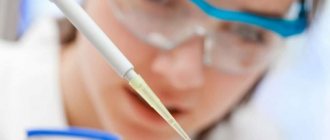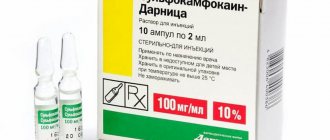Note!
Description of the drug Methylene blue aqueous solution (Methylene blue) on this page is a simplified author’s version of the apteka911 website, created on the basis of the instructions for use. Before purchasing or using the drug, you should consult your doctor and read the manufacturer's original instructions (attached to each package of the drug).
Information about the drug is provided for informational purposes only and should not be used as a guide to self-medication. Only a doctor can decide to prescribe the drug, as well as determine the dose and methods of its use.
Effect of methylene blue on human sperm motility in vitro
Evdokimov V.V., Isaev N.K., Turovetsky V.B., Pirutin S.K.
Information about authors:
- Evdokimov V.V. – Doctor of Medical Sciences, Ch. Researcher, Department of Andrology and Human Reproduction, Research Institute of Urology and Interventional Radiology named after N.A. Lopatkina - branch of the Federal State Budgetary Institution "National Medical Research Center of Radiology" of the Ministry of Health of Russia, [email protected] mail.ru. AuthorID 543052
- Isaev N.K. – Doctor of Biology, Leading Researcher, Faculty of Bioengineering and Bioinformatics, Moscow State University. M.V. Lomonosov, Moscow,; AuthorID 89160
- Turovetsky V.B. – Ph.D., senior researcher at Moscow State University. M.V. Lomonosov, Faculty of Biology, [email protected] , AuthorID 85978
- Pirutin S.K. – Ph.D., senior researcher at Moscow State University named after M.V. Lomonosov, Faculty of Biology, Pirutin, AuthorID 91321
Currently, the demographic situation in the country is characterized by a falling birth rate. This trend, according to demographers, will continue for several years. According to WHO, the percentage of infertile marriages in different countries reaches 10-15% of the total number of married couples. In the Russian Federation, according to the National Medical Research Center for Obstetrics, Gynecology and Perinatology named after. IN AND. Kulakov, this number is 17%, and more than 4 million men are diagnosed with infertility of various forms [1-3].
In recent years, reproductive dysfunction in men has been of particular medical and social significance due to the progressive decline in the fertile properties of sperm [4,5]. Fertility disorders are considered as a multifactorial condition that can be mediated by the presence of pathological changes in the organs of the reproductive system (varicocele, prostatitis, sexually transmitted infections, cryptorchidism, hypogonadism, etc.), as well as the influence of external factors (smoking, alcohol, physical inactivity, obesity , electromagnetic radiation from various sources, unfavorable environmental factors, occupational hazards) [6]. These effects may simultaneously increase changes in reproductive function and cause hormonal imbalances. In all likelihood, the combination of these factors leads to a high percentage of idiopathic infertility, reaching 30-50% in the structure of male infertility, which causes not only the difficulty of diagnosis, but also the choice of treatment tactics for identified disorders [7].
Until now, treatment and diagnosis of male infertility remain ineffective; correction of male fertility disorders does not always lead to positive results. In this case, to normalize the structural and functional state of male germ cells, hormonal drugs, vitamins, microelements, antioxidants, etc. are used. However, the effect of such treatment does not always satisfy both the patient and the doctor. Therefore, one of the urgent tasks of modern andrology is the search for agents that can increase sperm motility, as well as increase their resistance to damaging factors of various natures.
Previously, we carried out a number of experiments aimed at finding ways to increase male fertility by increasing sperm motility using regulatory peptides [8] or a protein-peptide complex (PPC) obtained from bovine testes. [9]. Studies have shown that regulatory peptides and BOD preparations had a pronounced ability to increase both active and overall sperm motility.
Subsequently, an analysis of the literature indicated the possibility of using methylene blue (MB) as an agent influencing the functional activity of sperm [10,11]. We hypothesized that it is possible to increase sperm motility with the help of substances that can directly affect the functioning of mitochondria, one of such agents is methylene blue. A number of studies have noted a positive effect of exposure to methylene blue, where the development of cellular damage is associated with disruption of mitochondrial functions [12]. Currently, MS is used in medicine as an antiseptic and for the treatment of methemoglobinemia, vasoplegic syndrome and phosphamide neurotoxicity. Moreover, neuroprotective properties of MS have been demonstrated in models of stroke, Alzheimer’s and Parkinson’s diseases [13, 14]. The authors attribute the protective effect to the fact that MS enhances autophagy, reduces cerebral edema, and also inhibits microglial activation and reduces inflammation. It should be noted that chemically this substance is a tricyclic phenothiazine [15] and in mitochondria can act as a catalyst for the redox cycle.
M. Oz et al. demonstrated the effect of MS in an experiment. They showed that this drug is capable of reducing organ dysfunction in rats caused by exposure to a number of damaging factors. In vitro experiments have shown that MS effectively reduces the death of cultured neurons caused by paraquat or zinc ions, the toxic effect of which is directed towards mitochondria [14].
In connection with the above, the objective of this work is to study the biological effect of the drug methylene blue on the motility and viability of human sperm.
MATERIALS AND METHODS
The studies were carried out on human spermatozoa from ejaculate obtained in the generally accepted way. After liquefaction after 40-60 minutes, the ejaculate was microscoped in transmitted light at a magnification of x400 on an Amplival microscope (Karl Zeiss, Iena). Sperm motility and other ejaculate parameters were assessed according to the WHO standard, 5th edition [16]. The experiments were carried out at a temperature of 20–22ºС. From the resulting ejaculate sample, 1 ml was taken for experiment and control. The MS preparation was added to the test tube to a final concentration of 1 nM.
The results obtained are presented in the form of arithmetic average values of the studied parameters and their root-mean-square errors. The experimental results were processed statistically using the Student's t test. Differences between the arithmetic mean values of the parameters were considered significant at p<0.05.
RESEARCH RESULTS
We conducted a series of experiments with motile cells - sperm. In one series of experiments, ejaculate (13 patients) with initial low sperm motility was used (Table 1). Another series used ejaculate samples (10 patients) with initial normal sperm motility (Table 2). Sperm motility (total, active and low) was calculated as the content of motile cells in the ejaculate per 100 analyzed. Total mobility is the sum of active and low mobility fractions. The tables in brackets show the results relative to the initial level, taken as relative 100%.
With initial asthenozoospermia (Table 1), active mobility increased significantly in the first 30 minutes of the experiment, then decreased to the initial level. Low mobility after 2 hours of observation noticeably decreased, and overall mobility also, after some increase, fell to the initial level.
Table 1. The effect of methylene blue on sperm motility in the initial asthenozoospermia (total motility – less than 40% )
*differences in mobility values compared to the initial level are significant (p<0.05).
With normozoospermia (Table 2), active mobility changed significantly over 2 hours of observation. Low sperm motility changed less significantly during this period; overall motility increased significantly in the first 30 minutes, then decreased to the initial level. In this case, a more pronounced response of actively motile forms of sperm to the effect of the drug can be identified.
Table 2. The effect of methylene blue on sperm motility in the initial normozoospermia (total motility – less than 40% )
*differences in mobility values compared to the initial level are significant (p<0.05).
In control samples, mobility after 2 hours of observation in all cases remained at the original level.
The number of living forms of sperm during the experiment in both cases (astheno and normozoospermia) remained at the original level of 60 – 64%.
Thus, adding MS to the ejaculate within 30 – 60 minutes. incubation changed all forms of sperm motility to varying degrees. With increasing incubation time, the effect of increasing sperm motility was not observed.
DISCUSSION
The results of the study of the effect of MS on sperm with the leading form of pathospermia - asthenozoospermia - show the presence of significant changes in the main functional parameters of the ejaculate. The response of sperm to the effects of MS in different groups is different both in time and in effect. The most pronounced increase in motility was observed in the fraction of actively motile spermatozoa in the first 30–60 minutes of the experiment. After 2 hours, in all ejaculate samples, including the control, motility returned to its original level. After 24 hours of observation, all types of mobility decreased to 20-50% relative to the initial level, in the control - to 2-60%.
Currently, the mechanism of the restorative and stimulating effect of the drug on various cells is not completely clear, however, there are indications in the literature that these properties are to a certain extent associated with the effect on calcium homeostasis and the functional state of mitochondria [17,18].
It has been shown that MS is able to reduce organ dysfunction in rats as a result of exposure to a number of damaging factors. In vitro experiments have shown that MS effectively reduces the death of cultured neurons caused by paraquat or zinc ions, the toxic effect of which is aimed at mitochondria [19,20].
In addition, as is known, sperm motility is ensured by the energy of glycolysis, one of the enzymes of which is glyceraldehyde 3-phosphate dehydrogenase - GAPDH, which is tightly bound in the sperm to the fibrous layer of the flagellum [21]. According to the authors, sperm motility largely depends on the activity of this enzyme, which is very sensitive to the damaging effects of reactive oxygen species (ROS). This suggests that an increase in sperm motility can be achieved using a number of agents (including, possibly, some regulatory peptides) that reduce the increased production of ROS, which is observed in a number of urological diseases, including those of the urogenital system.
Thus, the conducted studies revealed the ability of MS to stimulate the motility of human spermatozoa in experiments. Although the mechanism of the observed effect remains unclear, the data obtained show the promise of further work to study the possibility of using the drug in andrological and reproductive practice.
LITERATURE
- Shcheplev P.A. Andrology. Clinical recommendations. M., Medical practice. 2007. 154 p. (Scheplev PA Andrology. Clinical recommendations. M., medical practice. 2007.154 s.)
- Kulakov V.I. Assisted reproductive technologies present and future. M. Medical information agency. 2005. pp. 11-15. (Kulakov VI Assisted reproductive technologies present and future. M. Medical news. 2005.P. 11-15.)
- Pashkova E.Yu., Kalinchenko S.Yu. Male infertility in the 21st century - realities and prospects. Effective pharmacotherapy. Urology and Nephrology 2013;(1): 26-32. (Pashkova E.Yu., Kalinchenko S.Yu. Male infertility in the 21st century realities and prospects. Effective pharmacotherapy. Urology and Nephrology 2013; (1): 26-32.)
- Vinogradov I.V., Gablia M.Yu. The role of the male factor in the analysis of failures in ART protocols. URL: https://uronews.ru/2012/10/vliyanie-muzhskogo-faktora-na-veroyatnostneudachi-v-protokole-vrt/. (Vinogradov IV, Gabliya M.Yu. e role of the male factor in the analysis of failures in ART protocols. URL: https://uronews.ru/2012/10/vliyanie-muzhskogofaktora-na-veroyatnost-neudachi-v -protokole-vrt/)
- Ovchinnikov R.I., Gamidov S.I. The causes of reproductive losses in men are fragmentation of sperm DNA. RMJ 2015;(11):634-638. (Ovchinnikov RI, Hamidov SI The causes of reproductive loss in men are sperm DNA fragmentation. RMJ 2015; (11): 634-638.)
- Bykov V.L. Spermatogenesis in men at the end of the twentieth century (literature review). Reproduction Problems 2000;(1): 6-13. (Bykov VL Spermatogenesis in men at the end of the twentieth century (literature review). Reproduction Problems 2000; (1): 6-13.)
- Kellet E.P., Korneeva I.E., Shurshalina A.V. Infertility of unknown origin: the focus of modern scientific research. Problems of Reproduction 2010;(1): 32-35. (Kellat EP, Korneeva IE, Shurshalina AV Infertility of unknown origin: the focus of modern scientific research. Reproduction Issues 2010; (1): 32-35.)
- Evdokimov V.V., Zakharikov S.V., Andreeva L.A., Myasoedov N.F., Turovetsky V.B. Effect of regulatory peptides on human sperm motility in vitro. Experimental and Clinical Urology 2016;(2):67–69. (Evdokimov VV, Zakharikov SV, Andreeva LA, Myasoedov NF, Turovetsky VB e effect of regulatory peptides on in vitro human sperm motility. Experimental and clinical urology 2016; (2): 67–69.)
- Yamskova V.P., Krasnov M.S., Yamskov I.A. New experimental and theoretical aspects in bioregulation. The mechanism of action of membranotropic homeostatic tissue-specific bioregulators. Saarbucken. Lambert Academic Publishing, 2012. 127 pp. (Yamskova VP, Krasnov MS, Yamskov IA New experimental and theoretical aspects in bioregulation. The mechanism of action of membranotropic homeostatic tissue-specific bioregulators. Saarbucken Lambert Academic Publishing, 2012.127 p.)
- Wood BL, Doncel GF, Reddy PR, Sokal DC. Effect of diltiazem and methylene blue on human sperm motility, viability and cervical mucus penetration: potential use as vas irrigants at the time of vasectomy. Contraception 2003;67(3):241-5.
- Chandler JE, Harrison CM, Canal AM. Spermatozoal methylene blue reduction: an indicator of mitochondrial function and its correlation with motility. Theriogenology 2000;15;54(2):261-71.
- Wainwright M, Amaral L. The phenothiazinium chromophore and the evolution of antimalarial drugs. Trop Med Int Health 2005;10(6):501–511. doi: 10.1111/j.1365-3156.2005.01417.x
- Watts LT, Lloyd R, Garling, RJ Stroke neuroprotection: targeting mitochondria. Brain Sci 2013;3(2):540-560. doi: 10.3390/brainsci3020540.
- Oz M, Lorke DE, Petroianu GA. Methylene blue and Alzheimer's disease. Biochem Pharmacol 2009. 78, 927-932.
- Stelmashuk E.V., Genrikhs E.E., Mukhaleva E.V., Skrebitsky V.G., Isaev N.L. Neuroprotective effect of methylene blue in vivo and in vitro. Bulletin of Experimental Biology and Medicine 2019;167(4): 438-443. (Stelmashuk EV, Genrikhs EE, Mukhaleva EV, Skrebitsky VG, Isaev NL Neuroprotective effect of methylene blue in vivo and in vitro. Bulletin of experimental biology and medicine 2019; 167 (4): 438-443.)
- WHO guidelines for the examination and processing of human ejaculate. 5th ed. 2012, M.: 291 p. (WHO guidelines for the study and treatment of human ejaculate. 5th ed. 2012, M .: 291 p.)
- Poteet E, Winters A, Yan LJ, Yang SH. Neuroprotective action of methylene blue and its derivatives. PLoS One 2012;7(10):e48279. doi: 10.1371/journal.pone.0048279.
- Zhao M, Liang F, Xu H, Yan W, Zhang J. Methylene blue exercises a neuroprotetive effect against traumatic brain injury by promoting autophagy and inhibiting microglial activation. Mol Med Rep 2016;13(1):13-20. doi: 10.3892/mmr.2015.4551
- Sharpley MS, Hirst J. The inhibition of mitochondrial complex1 (NADH:ubiquinone oxidoreductase) by Zn2+. J Biol Chem 2006;281(46):34800-9.
- Suh SW, Chen JW, Motamedi M, Bell B, Listiak K, Pons NF, et al. Evidence that synaptically – released zinc contributes to neuronal injury after traumatic brain injury. Brain Res 2000;852(2):268-273.
- Shutskaya Yu.Yu., Elkina Yu.L., Muronets V.I. Study of glyceraldehyde-3phosphate dehydrogenase from human spermatozoa. Biochemistry 2008;73(2):228-236. (Shutskaya Yu.Yu., Elkina Yu.L., Muronets VI The study of glyceraldehyde 3-phosphate dehydrogenase from human sperm. Biochemistry 2008; 73 (2): 228-236.)
The article was published in the journal “Experimental and Clinical Urology” No. 3 2021, pp. 50-53
Topics and tags
Male infertility
Magazine
Journal "Experimental and Clinical Urology" Issue No. 3, 2019
Comments
To post comments you must log in or register



